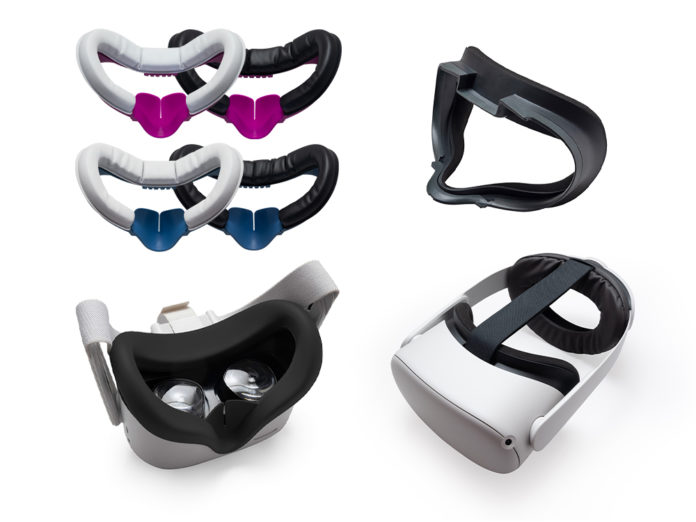The Oculus Quest 2 has been out for a while now, and third party companies have had time to develop a range of aftermarket accessories and solutions, all designed to improve comfort, enhance sweat-proof protection, and increase useability.
Top of that company list is VRCover. They have provided excellent aftermarket replacement interface and cover options for every major virtual reality headset, since the launch of the original Oculus Rift CV1 and HTC Vive back in 2016. Their products have been enjoyed and endorsed by thousands of VR consumers over the past few years so I was excited to test out their full Oculus Quest 2 product range.
I requested some samples for a hands-on look at their wares and VRCover obliged, sending out a bumper pack of goodies for me to review.
Just as Oculus offers a premium elite head strap and a basic, stock soft strap for its Quest 2 headset so too does VRCover have options for both those on a budget, as well as those willing to spend a little more for a higher-quality alternative. I’ll cover these in turn beginning with their most affordable offerings.
We’ll start by looking at the most affordable way to sweat-proof your headset and to improve headset comfort. These options are Silicon Covers, and the Head Strap Foam Pad.
For those happy to spend a bit more we’ll move on to VRCover’s own Facial Interface and Foam Replacement, and take a look at their Elite Head Strap Foam Pad, for use with the official Oculus elite head strap.
Finally, we’ll consider the controller offerings, and examine the Controller Grips and Halo Controller Protector.
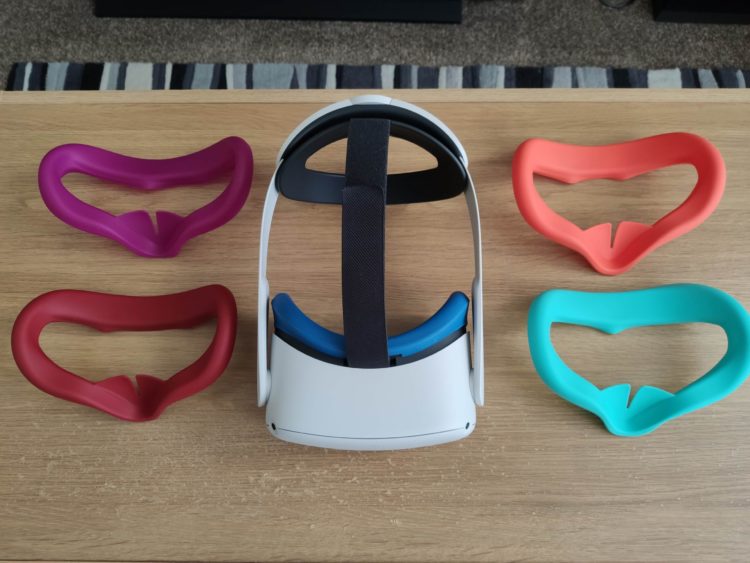
Affordable Sweat Protection – Silicone Covers $14 each
If you’re planning on using your Quest 2 for any active games, and especially to exercise in then sweat proofing the headset is essential. The Quest 2 comes with a stock foam facial interface that will absorb sweat. The foam pad is non-removable and regular washing will likely remove the glue causing it to fall apart. To prevent your Quest face pad from becoming a disgusting biome for microorganisms over time a silicone cover is a cheap, no-frills, but a perfectly adequate solution.
As you can see you can choose from a variety of colors, and they simply slip over the Quest interface, protecting the foam pad, and can be removed and washed clean after use.
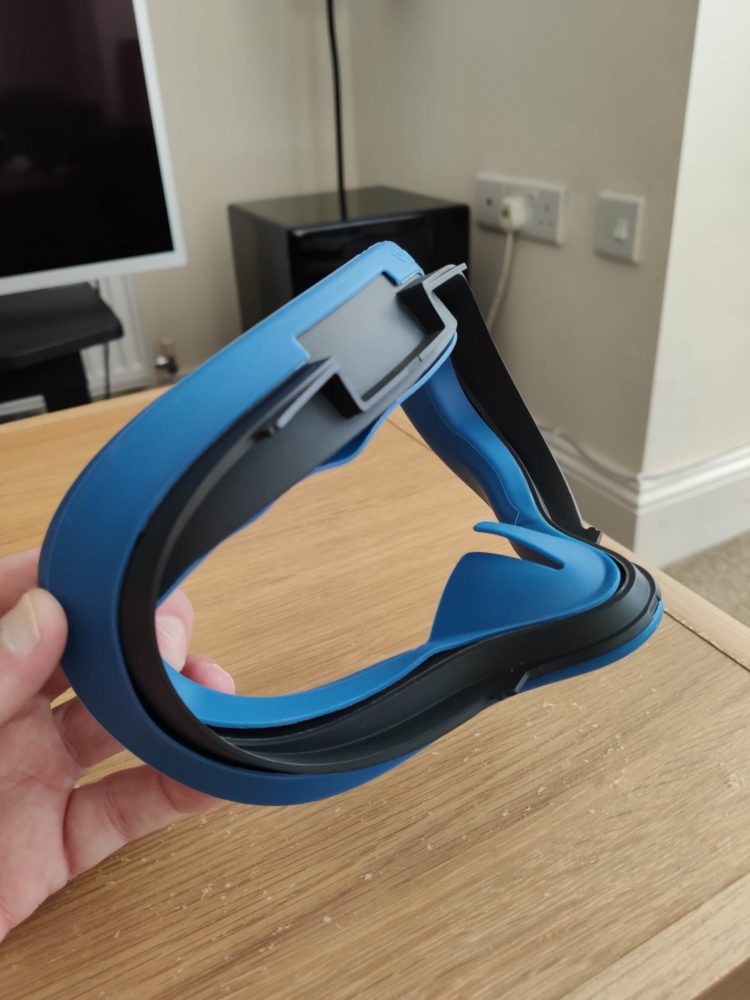
In terms of sweat protection these do an excellent job and for a relatively modest outlay. Silicone is durable, easy to clean, and maintains its shape so its practical utility is high. There are some negatives, however. The covers are a little fiddly to take on and off and I’m personally not a huge fan of silicone as a material. It attracts dust and lint like no other substance I know of. I also find it feels a bit cold and unpleasant on my skin, but if you’re not a precious baby like myself you can certainly make do with one of these and be confident that your headset is adequately protected.
If you just want something you can slip over your stock facial interface prior to a heavy Beat Saber session then a silicone cover will do the job, but they aren’t exactly luxurious. Overall, they feel to me like something I’d expect a VR arcade to use, rather than a discerning home user. If you share a headset between several family members then silicone covers are a good choice, each kid can have their own preferred color, and whip them off after use but if the headset belongs to you alone, and you’re planning on exercising regularly in your Quest I’d personally recommend investing a little more and going for VRCover’s more premium facial interface and foam replacement which I’ll cover shortly. That’s just me though, and if all you want is something that does the job it’s supposed to do, well these are definitely effective.
![]()
Silicone Cover Summary
+ Affordable, effective sweat protection. Durable and easy to clean after use.
+ Come in a variety of attractive colors, ideal if you have several children sharing a headset.
– Can be fiddly to take on and off, potentially irritating to delicate skin, and look a bit cheap. Dust magnets.
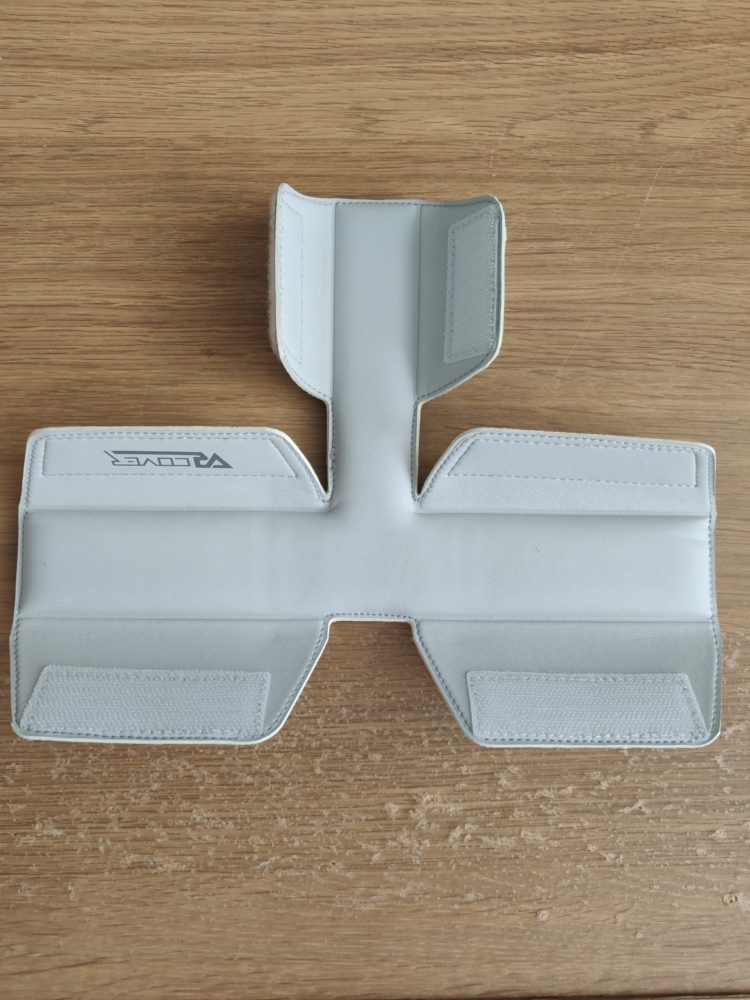
Affordable Comfort – Head strap foam pad – $19
I have to say receiving this item initially surprised me. As someone who pre-ordered both the Quest 2 and the Elite head strap together my only experience with the soft stock strap had been in hastily pulling it off my headset and condemning it to the back of a drawer, with the intention of never looking at it again.
Releasing a padded cushion for this piece of canvas string seemed tantamount to putting leather seats in a rusty old car that you had salvaged from a scrapyard.
I was annoyed that it meant digging the strap out of its place of purgatory in order to fit this foam pad to it and test it out.
However, my skepticism was somewhat misplaced. Contrary to my lowly expectations this pad really does make the stock strap a lot more comfortable. So comfortable in fact that I kept it on for a week because I simply forgot to swap back to my proper elite head strap.
I’ll go even further and say that this foam pad on the stock soft strap, is actually MORE comfortable for me overall than the elite head strap, as the rigid rear head support of the elite strap doesn’t really fit my head well, and actually digs in a little.
When it came to watching Netflix in bed or reclining on my sofa, this foam pad made the stock strap far more comfortable than the elite strap to wear.
It’s surprising how such a relatively small addition can make something that was previously manifestly unfit for purpose, into something I actually enjoyed wearing.
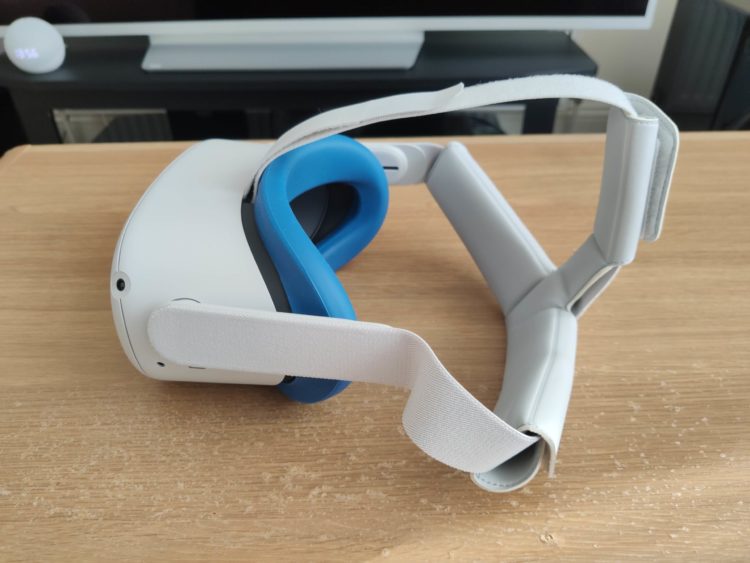
If you are happy with the soft stock strap and you don’t want to spend out on the elite strap this foam pad is an easy recommendation. It really does make that strap a lot more comfortable.
Now, there are some caveats. Because the velcro pad goes over the strap adjustment cords at the back, you’ll need to remove it, or at least open it up every time you want to adjust the strap fit and tightness. I found that over the course of the week the head strap gradually got looser, and having to open up the velcro on the foam pad to adjust was a lot more time-consuming than simply dialing the ratchet on the back of the elite strap.
There’s also the aesthetics to consider. The canvas strap to my eyes looks horrendously cheap and ugly and has no place on a consumer device costing hundreds of dollars. But then I’d not be seen dead wearing a canvas belt either, nor sweatpants for that matter. If you’re a scruffy slob, lacking my sartorial elegance (I’m totally kidding), and are even happy to be seen outside the house in loungewear then the threadbare, peasant appearance of the soft strap might not be a bother to you, in which case I’d actually recommend the foam pad highly. It really does make the soft strap more comfortable.
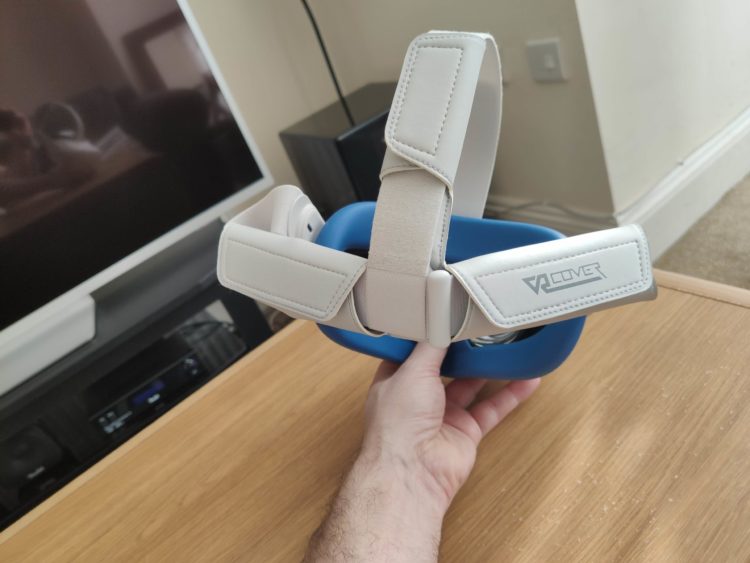
Soft Strap Foam Pad Summary
+ Really does improve comfort and makes the soft strap much more pleasant to wear
+ Helps to secure the headset more fully and prevents it from sliding down
+ The soft pillowed cushion means the soft strap is excellent for media consumption and watching videos lying down
– It’s hard to make strap adjustments as the velcroed pad covers the adjusters at the back of the head strap.
– This is solely subjective, but the soft strap itself is pretty cheap and ugly looking, and to my fussy eye ruins the look of the device.
Stepping up the Quality
So we’ve taken a look at the most cost-effective ways of sweat proofing your headset and making it more comfortable to wear, and in all honesty, despite my somewhat tongue in cheek criticisms of these entry-level accessories, they do serve their intended purposes as well as the more premium offerings that we’ll explore now.
As is usually the case in life, however, spending a little more, to get something of higher quality does tend to be worth it, especially if you’re planning on spending a lot of time using your headset.
In this section, we’ll take a look at VRCover’s trademark offering, their facial interface and foam replacement, as well as their padded cushion for the more expensive Oculus official elite head strap.
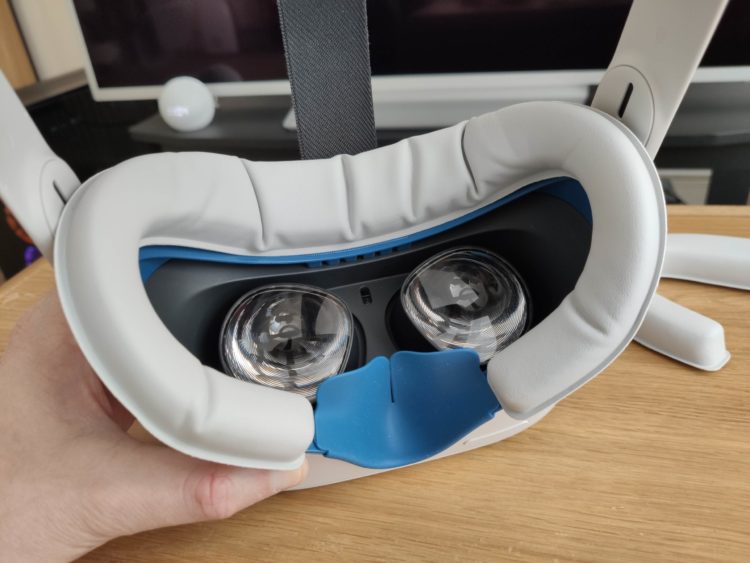
Premium Sweat Proof Protection – Facial Interface and Foam Replacement – $29
We now come to VRCover’s bread and butter. Replacement facial interfaces are what VRCover is known for, they have been developing them for years, and for multiple headsets. As you’d expect from the market leader, and most experienced company in this sphere they have got rather good at them, and their Quest 2 interface might just be their best yet.
This largely comes down to the material used. The all-new foam that is used for the Quest 2 pad is both soft, and comfortable, but also has an incredible disappearing quality. It quite literally melts onto your face. This confers a very useful advantage over other solutions, as it allows your face and eyes to get much closer to the interface and the all-important LCD display behind it. As a result, there is a modest, but definitely noticeable increase to the field of view (FOV) when compared to the stock foam pad that Oculus ships the Quest with.
The interface also has a rubberized nose strip, the purpose of which is to reduce lens fogging and light leakage. Regarding the former, for me, it doesn’t really succeed. I suffer slightly more lens fog with this interface than the stock Oculus one. This might be peculiar to me though as I sweat more from my forehead than any other part of my body. After a workout, my face will usually be dripping wet, whilst under my arms are completely dry, it’s weird I know. Regardless, the fogging problem is relatively minor, lasting a few minutes and then resolving itself. Where the nose strip does have value for me is in stopping light leakage. It does a significantly better job than the stock interface.
Improved FOV and reduced light leakage are nice bonuses to have, and when you factor in the additional comfort as well as its easy wipe clean design and better sweat proofing, then I regard the facial interface and foam replacement as a significant upgrade over the stock Oculus interface, and is, in fact, the single most essential Quest accessory upgrade that I own.
It does cost just over twice as much as a silicone cover, but I still regard this as better value for money, considering how much nicer the interface is to use, how much better it looks, and how it actually improves your visual experience, albeit by just a modest amount.
The interface ships with two foam pads, one slim fit that allows you to get as close as possible to the interface and the screen beyond, and a thicker, ‘comfort’ fit that offers more foam, and hence more padding. Personally, the slim fit is my favorite as I like to get as close to the screens as possible, and it does this without sacrificing comfort.
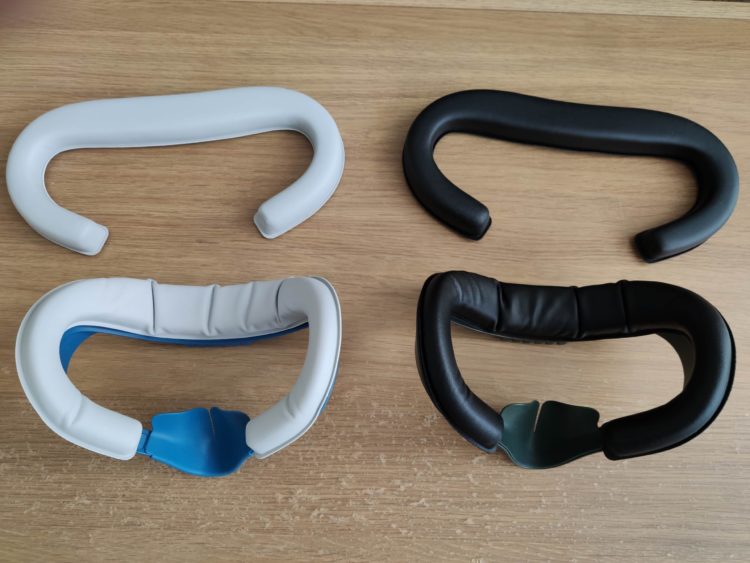
As you can see above I have two different color options sent to me by VRCover. I’ve been using the standard black interface with black foam pads, but they have also provided me with this rather attractive blue interface with grey foam. On their website, you’ll see further color options including red and magenta interfaces. When ordering you can select both the interface and foam pad color, allowing you to personalize your device.
TIP – A note of caution for glasses wearers who use the spacer insert with the stock Quest 2 interface, this spacer does not fit with the VRCover interface. VRCover does sell their own XL spacer to fit own their interface, for $9, so it does increase the overall cost slightly.
Facial interface and foam replacement summary
+ My favorite Quest 2 accessory, would not be without it!
+ Very comfortable, dual foam pad solution that allows you to select your preference
+ Modest FOV increase, and reduced light leakage
+ Easily wipeable, removable, and excellent quality
– It’s more expensive than a silicone cover but well worth the additional cost in my opinion.
– Glasses wearers who use the spacer insert will have to pay a little extra for VRCover’s spacer too.
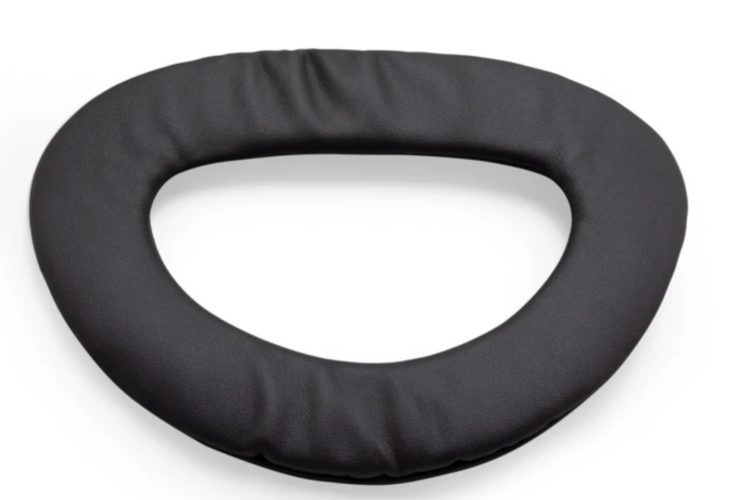
Elite head strap foam pad $19
Unfortunately, as I write this VRCover’s elite head strap foam pad is out of stock, and thus they haven’t yet been able to send one to me. Nonetheless, based on the effectiveness of their soft strap foam pad I have high hopes that this will provide a significant comfort boost. As you can see from the picture below the pad slides over and cushions the rigid plastic head cup at the base of the head strap. As soon as I get hold of one I will update here with my hands-on opinion, it sure looks nice though.
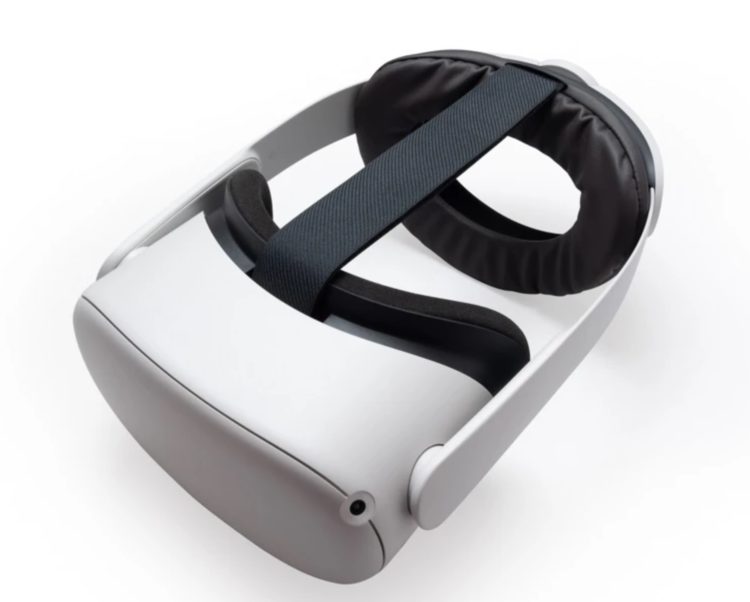
Pimp out your controllers
A sweat proofed headset, nicely cushioned for your pampered bonce will certainly improve your VR experience. But why stop there? The Quest 2 comes with a pair of Oculus Touch controllers and thanks to VRCover’s controller accessories you can treat these to a nice upgrade too. In this final section we are looking at controller grips, and Halo controller protectors.
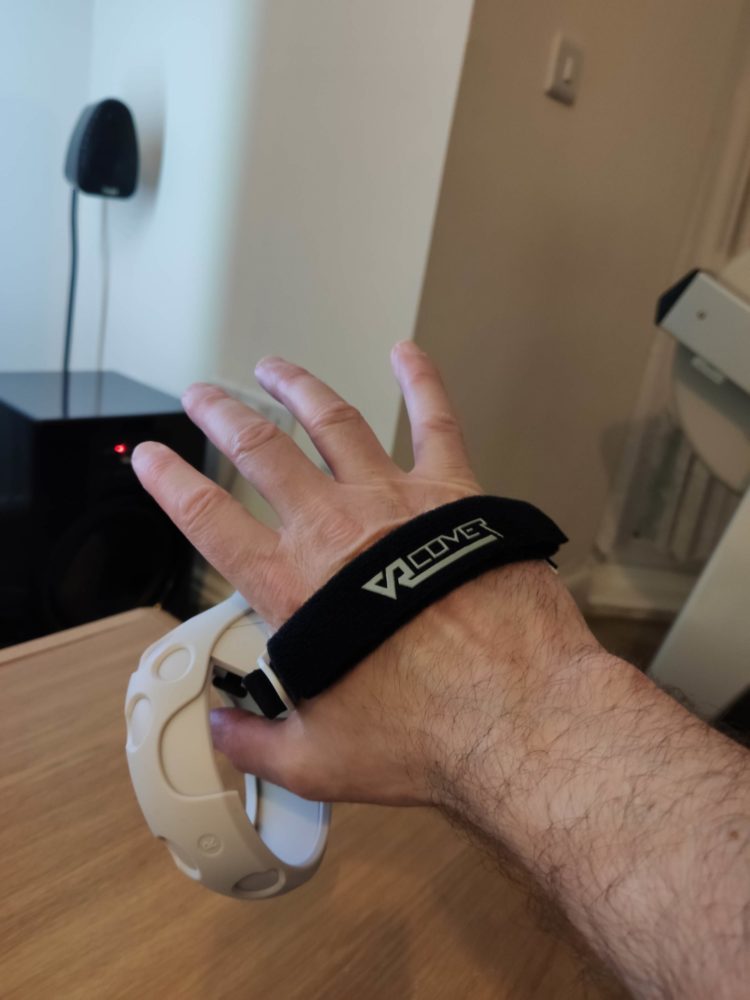
Controller grips $29 Halo Protectors $15
At $29 I consider the controller grips to be more of a luxury buy than an essential purchase, you can get by just fine without them. However, for the right user, they confer some great practical benefits, and it’s hard to go back to the plain, naked Touch controllers after using these for a period of time. So what’s good about them?
Well, firstly, they will greatly reduce your chances of launching a controller across the room when you throw a grenade in Pavlov or swing wildly in Beat Saber. Thanks to the rubber straps, (which you can adorn with the optional, included felt handles as I have in the photo above) the controller is totally secure in your hand whether you close your palm around it or not. Furthermore, it improves immersion by allowing you to let go of your grip when you aren’t holding anything in-game. The material used is a kind of rubberized plastic. It’s very flexible and soft, with no risk of snapping or breaking. Having a textile grip that your palm wraps around is a much nicer feeling than the smooth, featureless handles of the controllers in their naked form.
They do obstruct the battery casing, so you will need to slide them off to change batteries. But I’ve had my Quest 2 since launch day and am still only on my second pair, so this is no real inconvenience. The only negative I can think of is that people with smaller hands might feel the grips increase the already slightly bulky size of the Quest 2 controllers, but this wasn’t an issue for me.
Tip – You can thread the Quest 2 Controller strings through a hole at the bottom of the grips, but it’s better to just remove the strings entirely. To do this simply slide off the battery case, and you’ll see that you can unclip and lift them out. This looks a lot tidier!
The Halo protectors are a separate purchase from the controller grips, but if you’re going to buy the grips you really should get these too. As you can see in the photo below they really do pair well together, creating a rugged, ‘ready for war’ type look that I personally find very visually appealing. The halo protectors slide easily over your controller rings, with holes corresponding to where the infrared sensors are so that the headset’s view of the controllers is not obstructed. As a positive side effect, they give the controllers a military-type feel. The all grey version that I have gives me definite Storm Trooper vibes, and I love them!
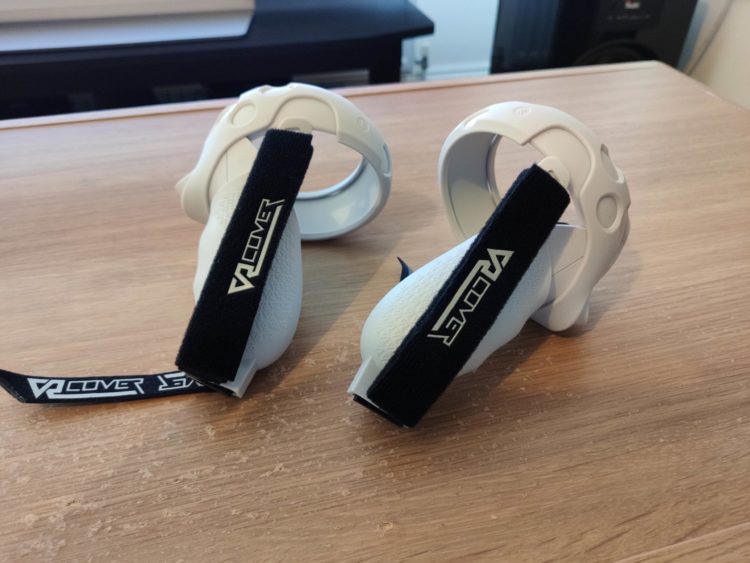
Tip – Grips and Halo protectors are actually a prudent investment if you intend to sell your headset in the future. The $44 cost for the grips and halo protectors combined is not trivial. However, if you intend to sell your device in the future I actually think they make for a very sensible purchase. Smashing controllers into walls and objects, to say nothing of smiting wandering children and pets is a fact of VR life. The rings will take the brunt of this and over time can get pretty scratched up. The halo protectors go a long way to reducing this wear and tear and having nice scratch free controllers will certainly help your Quest 2 sell better on eBay when you’re ready for the inevitable Quest 3. Headsets with additional accessories sell better as well, so you’ll end up making most of that money back, and have badass looking controllers to boot.
Grips and halo protector summary
+ Grips improve comfort, ergonomics, and immersion by allowing you secure, hands-free play
+ Solid protection for your controllers from scratches and cosmetic damage
+ A subjective opinion but I think the grips and halo protectors pair fantastically well to create a striking, visual aesthetic that makes your VR experience at least fifty percent cooler.
– If you have small hands, the grips might add even more bulk making the controllers less comfortable.
Summary
So that concludes my overview of VRCover’s Quest 2 accessories. I hope it’s been useful, if you have any questions feel free to ask in the comments. In conclusion, I’d say that VRCover’s range has something for everybody. If all you want is a way to stop the sweat when exercising a silicone cover is cheap and effective. The soft strap that comes with the Quest 2 is not the best, but the foam pad VRCover sells really does make it comfortable to wear at least, even if it can’t stop it from looking like cheap rubbish!
At the more premium end, VRCovers replacement interface and foam is simply my favorite Quest 2 accessory, and I wouldn’t be without it. I didn’t get to try the elite strap foam pad but will update once I have.
Finally, the controller grips and halo protectors are more luxury than a necessity, but they are of nice quality, look fantastic, and make using the controllers a more pleasurable and refined experience.
If you can’t already tell, I’m a VRCover fan. They make great products and you can’t go wrong with anything in their range.

